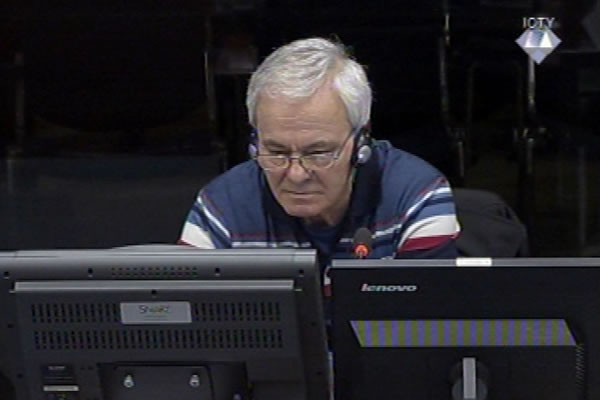Home
KARADZIC’S THEORY ABOUT BODIES IN TOMASICA
In the course of Dusan Jankovic’s evidence, Radovan Karadzic suggested that, after the attack on Prijedor, the Green Berets buried their dead fighters in the Tomasica mine. Jankovic, former commander of the Prijedor Public Security Station, was sentenced in Sarajevo to 21 years for the crime at Koricanske Stijene
 Dusan Jankovic, witness at the Radovan Karadzic trial
Dusan Jankovic, witness at the Radovan Karadzic trial Former commander of the Prijedor Public Security Station Dusan Jankovic testified at the trial of Radovan Karadzic. Last year Jankovic was sentenced by the BH Court to 21 years for the crime at Koricanske Stijene on 21 August 1992, when the Prijedor police intervention platoon executed about 200 Muslims travelling in a convoy escorted by the police en route to Travnik.
At the beginning of the witness’s evidence Karadzic indicated he would contest the prosecution’s allegations about the mass grave in the Tomasica mine near Prijedor. Jankovic said that a lot of fighters were wounded and killed in the attack launched by the Muslim forces on Prijedor on 30 May 1992. Karadzic could thus again air his favorite argument that the mass graves were the result of clean-up operations after combat. In his replies to the accused Jankovic said that he heard that the Green Berets had buried the fighters killed in action in the Tomasica area.
Jankovic claimed in his examination-in chief that the police reports from Keraterm and Omarska were sent only to the chief of the Prijedor police, Simo Drljaca. As far as Jankovic knew, Drljaca never ordered or committed any crimes. Sometimes Drljaca ‘acted arrogantly’ and refused to obey orders, but when pressure was exerted, Drljaca would eventually comply with them. Jankovic claimed that Drljaca was subordinated to the chief of the Banja Luka Security Services Center and the RS defense minister and had no contacts with Karadzic.
Through Jankovic’s evidence, Karadzic tried to refute the ‘adjudicated facts’ from the Tribunal’s previous trials about the Prijedor crimes. Karadzic also contested the facts established by the BH Court at Jankovic’s trial such as the real nature of Jankovic’s function as the commander of the Prijedor Police Station and his role in the crime at Koricanske Stijene. Jankovic argued that the witnesses lied before the BH Court when they said that they saw him escorting the convoy. They did so in a bid to get milder sentences following their plea agreements with the prosecution, Jankovic claimed.
Prosecutor Katrina Gustafson confronted the witness with several documents confirming that during the war he was the commander of the Prijedor Public Security Station. The witness remained adamant that the police station no longer functioned when the reserve police were called up in September 1991. Jankovic maintained that during the war, he mostly dealt with logistical issues. He couldn’t understand why someone in the Banja Luka Security Services Center called him on the phone the day after the Koricanske Stijene massacre to discuss it with him.
The members of the intervention platoon who took part in the massacre at Koricanske Stijene were not arrested and punished only because they ‘became outlaws and fled to the Kozara mountain’, Jankovic explained; in addition to that, ‘someone’ had made the decision not to arrest them in order to avoid the bloodshed.
Linked Reports
- Case : Karadzic
- 2014-02-17 SERB AUTHORITIES AND KORICANSKE STIJENE CRIME
- 2014-02-17 DISCOVERY OF A 20-YEAR OLD SECRET OR ‘PURE FICTION’?
- 2014-02-14 EVERYBODY HAD FREEDOM OF MOVEMENT, BUT ONLY MUSLIMS LEFT
- 2014-02-19 KARADZIC’S SWEET WITNESS
- 2014-02-20 KARADZIC DECIDES NOT TO TESTIFY IN HIS OWN DEFENSE
- 2014-02-27 KARADZIC WANTS ONE YEAR TO PREPARE HIS FINAL BRIEF
